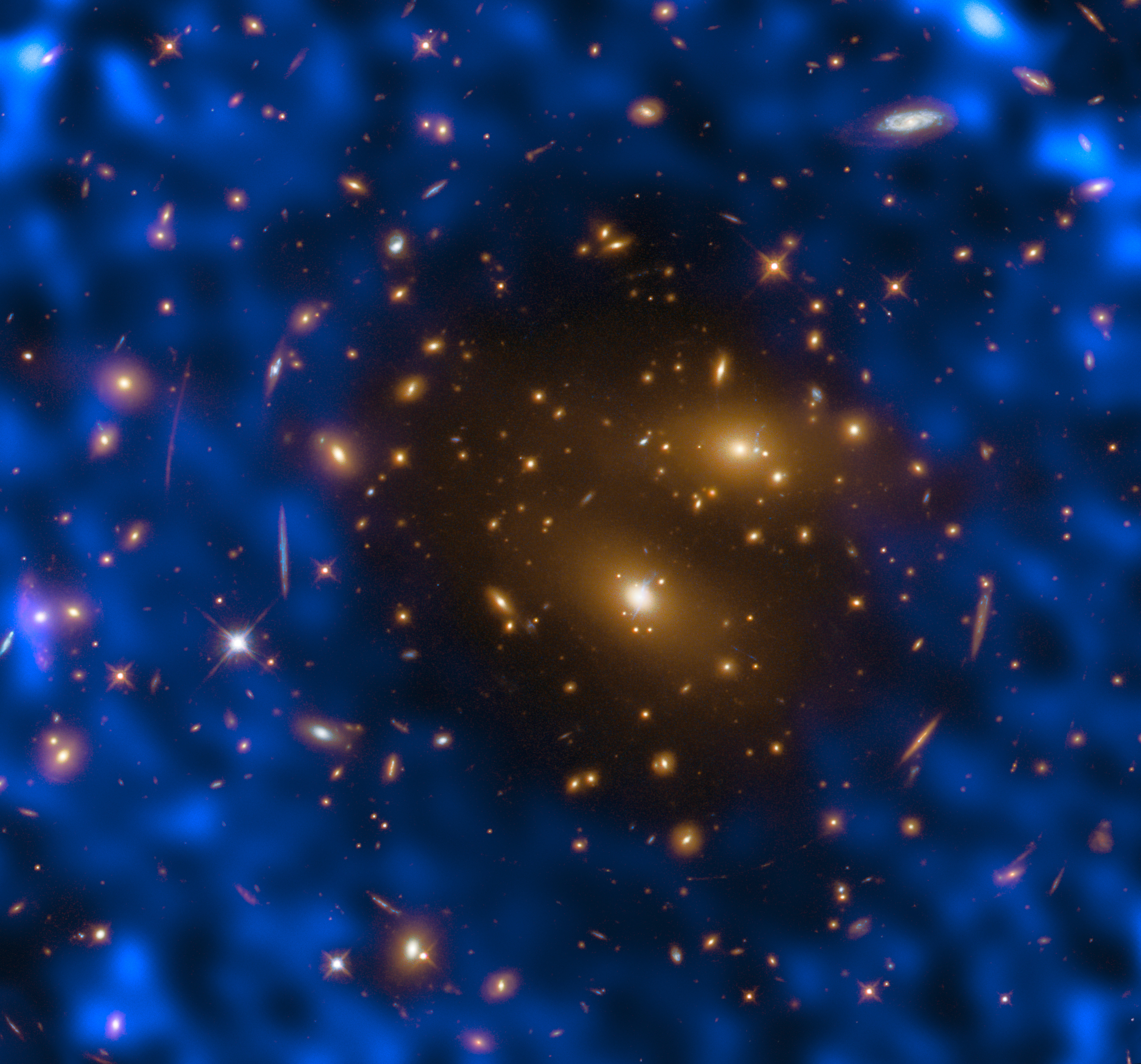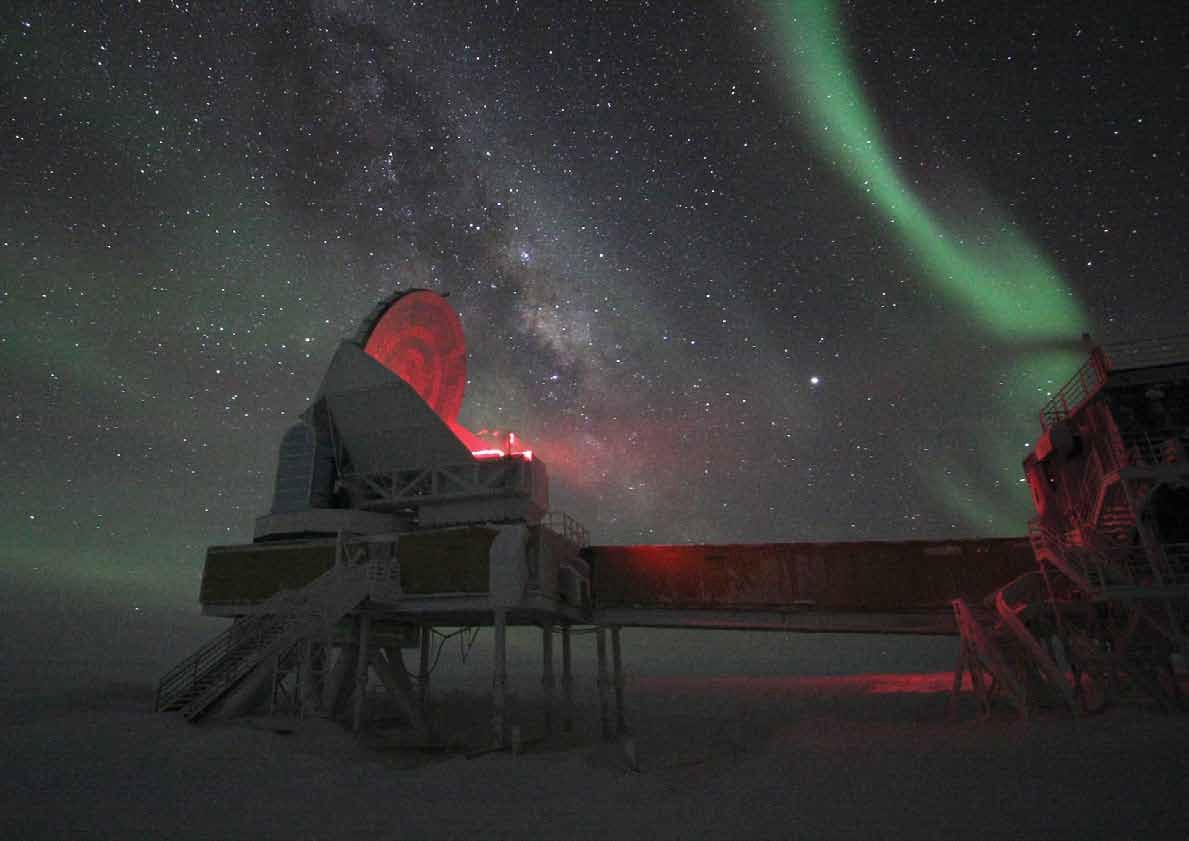|
Sunyaev–Zeldovich Effect
The Sunyaev–Zeldovich effect (named after Rashid Sunyaev and Yakov Zeldovich, Yakov B. Zeldovich and often abbreviated as the SZ effect) is the Cosmic microwave background spectral distortions , spectral distortion of the cosmic microwave background (CMB) through Compton scattering#Inverse Compton scattering, inverse Compton scattering by high-energy electrons in galaxy clusters, in which the low-energy CMB photons receive an average energy boost during collision with the high-energy cluster electrons. Observed distortions of the cosmic microwave background spectrum are used to detect the disturbance of density in the universe. Using the Sunyaev–Zeldovich effect, dense Groups and clusters of galaxies, clusters of galaxies have been observed. Overview The Sunyaev–Zeldovich effect was predicted by Rashid Sunyaev and Yakov Zeldovich to describe anisotropies in the CMB. The effect is caused by the CMB interacting with high energy electrons. These high energy electrons cause i ... [...More Info...] [...Related Items...] OR: [Wikipedia] [Google] [Baidu] |
Rashid Sunyaev
Rashid Alievich Sunyaev ( tt-Cyrl, Рәшит Гали улы Сөнәев, russian: Раши́д Али́евич Сюня́ев; born 1 March 1943 in Tashkent, USSR) is a Germany, German, Soviet Union, Soviet, and Russia, Russian astrophysicist of Tatar descent. He got his MS degree from the Moscow Institute of Physics and Technology (MIPT) in 1966. He became a professor at Moscow Institute of Physics and Technology, MIPT in 1974. Sunyaev was the head of the High Energy Astrophysics Department of the Russian Academy of Sciences, and has been chief scientist of the Academy's Space Research Institute since 1992. He has also been a director of the Max Planck Institute for Astrophysics in Garching bei München, Garching, Germany since 1996, and Maureen and John Hendricks Distinguished Visiting Professor in the School of Natural Sciences at the Institute for Advanced Study in Princeton since 2010. Works Sunyaev and Yakov Zeldovich, Yakov B. Zeldovich developed the theory for the evol ... [...More Info...] [...Related Items...] OR: [Wikipedia] [Google] [Baidu] |
Galaxy Cluster
A galaxy cluster, or a cluster of galaxies, is a structure that consists of anywhere from hundreds to thousands of galaxies that are bound together by gravity, with typical masses ranging from 1014 to 1015 solar masses. They are the second-largest known gravitationally bound structures in the universe after galaxy filaments and were believed to be the largest known structures in the universe until the 1980s, when superclusters were discovered. One of the key features of clusters is the intracluster medium (ICM). The ICM consists of heated gas between the galaxies and has a peak temperature between 2–15 keV that is dependent on the total mass of the cluster. Galaxy clusters should not be confused with ''galactic clusters'' (also known as open clusters), which are star clusters ''within'' galaxies, or with globular clusters, which typically orbit galaxies. Small aggregates of galaxies are referred to as galaxy groups rather than clusters of galaxies. The galaxy groups and c ... [...More Info...] [...Related Items...] OR: [Wikipedia] [Google] [Baidu] |
Galaxy Cluster
A galaxy cluster, or a cluster of galaxies, is a structure that consists of anywhere from hundreds to thousands of galaxies that are bound together by gravity, with typical masses ranging from 1014 to 1015 solar masses. They are the second-largest known gravitationally bound structures in the universe after galaxy filaments and were believed to be the largest known structures in the universe until the 1980s, when superclusters were discovered. One of the key features of clusters is the intracluster medium (ICM). The ICM consists of heated gas between the galaxies and has a peak temperature between 2–15 keV that is dependent on the total mass of the cluster. Galaxy clusters should not be confused with ''galactic clusters'' (also known as open clusters), which are star clusters ''within'' galaxies, or with globular clusters, which typically orbit galaxies. Small aggregates of galaxies are referred to as galaxy groups rather than clusters of galaxies. The galaxy groups and c ... [...More Info...] [...Related Items...] OR: [Wikipedia] [Google] [Baidu] |
Owens Valley Radio Observatory
Owens Valley Radio Observatory (OVRO) is a radio astronomy observatory located near Big Pine, California (US) in Owens Valley. It lies east of the Sierra Nevada, approximately north of Los Angeles and southeast of Bishop. It was established in 1956, and is owned and operated by the California Institute of Technology (Caltech). The Owens Valley Solar Array portion of the observatory has been operated by New Jersey Institute of Technology (NJIT) since 1997. One of the ten dish-antenna radiotelescope systems of the Very Long Baseline Array is located on a sublease within the Owens Valley observatory. About The Owens Valley Radio Observatory (OVRO), one of the largest university-operated radio observatories in the world, has its origins in the late 1940s with three individuals: Lee DuBridge, president of California Institute of Technology (Caltech); Robert Bacher, chairman of the Division of Physics, Mathematics and Astronomy; and Jesse Greenstein, professor of astrophysics. In 1954, ... [...More Info...] [...Related Items...] OR: [Wikipedia] [Google] [Baidu] |
Cavendish Astrophysics Group
The Cavendish Astrophysics Group (formerly the Radio Astronomy Group) is based at the Cavendish Laboratory at the University of Cambridge. The group operates all of the telescopes at the Mullard Radio Astronomy Observatory except for the 32m MERLIN telescope, which is operated by Jodrell Bank. The group is the second largest of three astronomy departments in the University of Cambridge. Instruments under development by the group * The Atacama Large Millimeter Array (ALMA) - several modules of this international project * The Magdalena Ridge Observatory Interferometer (MRO Interferometer) * The SKA Instruments in service * The Arcminute Microkelvin Imager (AMI) * A Heterodyne Array Receiver for B-band (HARP-B) at the James Clerk Maxwell Telescope * The Planck Surveyor Previous instruments * The CLOVER telescope * The Very Small Array * The 5 km Ryle Telescope * The Cambridge Optical Aperture Synthesis Telescope (COAST) * The Cosmic Anisotropy Telescope * The Cambrid ... [...More Info...] [...Related Items...] OR: [Wikipedia] [Google] [Baidu] |
Planck (spacecraft)
''Planck'' was a space observatory operated by the European Space Agency (ESA) from 2009 to 2013, which mapped the anisotropies of the cosmic microwave background (CMB) at microwave and infrared frequencies, with high sensitivity and small angular resolution. The mission substantially improved upon observations made by the NASA Wilkinson Microwave Anisotropy Probe (WMAP). ''Planck'' provided a major source of information relevant to several cosmological and astrophysical issues, such as testing theories of the early Universe and the origin of cosmic structure. Since the end of its mission, ''Planck'' has defined the most precise measurements of several key cosmological parameters, including the average density of ordinary matter and dark matter in the Universe and the age of the universe. The project was started around 1996 and was initially called COBRAS/SAMBA: the Cosmic Background Radiation Anisotropy Satellite/Satellite for Measurement of Background Anisotropies. It was l ... [...More Info...] [...Related Items...] OR: [Wikipedia] [Google] [Baidu] |
Atacama Cosmology Telescope
The Atacama Cosmology Telescope (ACT) is a cosmological millimeter-wave telescope located on Cerro Toco in the Atacama Desert in the north of Chile. ACT makes high-sensitivity, arcminute resolution, microwave-wavelength surveys of the sky in order to study the cosmic microwave background radiation (CMB), the relic radiation left by the Big Bang process. Located 40 km from San Pedro de Atacama, at an altitude of , it is one of the highest ground-based telescopes in the world. Cosmic microwave background experiments like ACT, the South Pole Telescope, the WMAP satellite, and the Planck satellite have provided foundational evidence for the standard Lambda-CDM model of cosmology. ACT first detected seven acoustic peaks in the power spectrum of the CMB, discovered the most extreme galaxy cluster and made the first statistical detection of the motions of clusters of galaxies via the pairwise kinematic Sunyaev-Zeldovich Effect. ACT was buit in 2007 and saw first light on October 2007 ... [...More Info...] [...Related Items...] OR: [Wikipedia] [Google] [Baidu] |
South Pole Telescope
The South Pole Telescope (SPT) is a diameter telescope located at the Amundsen–Scott South Pole Station, Antarctica. The telescope is designed for observations in the microwave, millimeter-wave, and submillimeter-wave regions of the electromagnetic spectrum, with the particular design goal of measuring the faint, diffuse emission from the cosmic microwave background (CMB). The first major survey with the SPT—designed to find distant, massive, clusters of galaxies through their interaction with the CMB, with the goal of constraining the dark energy equation of state—was completed in October 2011. In early 2012, a new camera (SPTpol) was installed on the SPT with even greater sensitivity and the capability to measure the polarization of incoming light. This camera operated from 2012–2016 and was used to make unprecedentedly deep high-resolution maps of hundreds of square degrees of the Southern sky. In 2017, the third-generation camera SPT-3G was installed on the teles ... [...More Info...] [...Related Items...] OR: [Wikipedia] [Google] [Baidu] |
Angular Size Redshift Relation
In astronomy, angular diameter distance is a distance defined in terms of an object's physical size, x, and its angular size, \theta, as viewed from Earth: d_A= \frac Cosmology dependence The angular diameter distance depends on the assumed cosmology of the universe. The angular diameter distance to an object at redshift, z , is expressed in terms of the comoving distance, r as: d_A = \frac where S_k(r) is the FLRW coordinate defined as: S_k(r) = \begin \sin \left( \sqrt H_0 r \right)/\left(H_0\sqrt\right) & \Omega_k 0 \end where \Omega_k is the curvature density and H_0 is the value of the Hubble parameter today. In the currently favoured geometric model of our Universe, the "angular diameter distance" of an object is a good approximation to the "real distance", i.e. the proper distance when the light left the object. Angular size redshift relation The angular size redshift relation describes the relation between the angular size observed on the sky of an ... [...More Info...] [...Related Items...] OR: [Wikipedia] [Google] [Baidu] |
Electromagnetic Spectrum
The electromagnetic spectrum is the range of frequencies (the spectrum) of electromagnetic radiation and their respective wavelengths and photon energies. The electromagnetic spectrum covers electromagnetic waves with frequencies ranging from below one hertz to above 1025 hertz, corresponding to wavelengths from thousands of kilometers down to a fraction of the size of an atomic nucleus. This frequency range is divided into separate bands, and the electromagnetic waves within each frequency band are called by different names; beginning at the low frequency (long wavelength) end of the spectrum these are: radio waves, microwaves, infrared, visible light, ultraviolet, X-rays, and gamma rays at the high-frequency (short wavelength) end. The electromagnetic waves in each of these bands have different characteristics, such as how they are produced, how they interact with matter, and their practical applications. There is no known limit for long and short wavelengths. Extreme ultr ... [...More Info...] [...Related Items...] OR: [Wikipedia] [Google] [Baidu] |
Hubble Constant
Hubble's law, also known as the Hubble–Lemaître law, is the observation in physical cosmology that galaxies are moving away from Earth at speeds proportional to their distance. In other words, the farther they are, the faster they are moving away from Earth. The velocity of the galaxies has been determined by their redshift, a shift of the light they emit toward the red end of the visible spectrum. Hubble's law is considered the first observational basis for the expansion of the universe, and today it serves as one of the pieces of evidence most often cited in support of the Big Bang model. The motion of astronomical objects due solely to this expansion is known as the Hubble flow. It is described by the equation , with ''H''0 the constant of proportionality—the Hubble constant—between the "proper distance" ''D'' to a galaxy, which can change over time, unlike the comoving distance, and its speed of separation ''v'', i.e. the derivative of proper distance with respect t ... [...More Info...] [...Related Items...] OR: [Wikipedia] [Google] [Baidu] |







